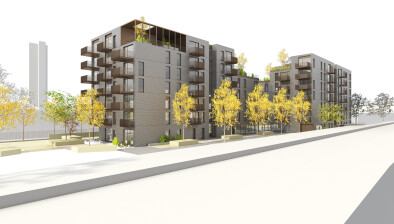Savills research unveils scale of sustainability challenge for real estate sector
The scale of the challenge facing the UK’s real estate sector in achieving net zero, with particular difficulties facing the residential sector due to its scale and the need to incentivise owner-occupiers to make improvements, has been highlighted in new research by Savills.

Whilst the commercial sector in general has specific advantages that will ease the challenge, Savills identifies major obstacles to upgrading the retail sector.
Savills has estimated that £330 billion is needed to implement all potential energy efficiency improvements the UK residential housing sector requires, in order to meet 2035 targets. As a whole, commercial property is considered to be less challenging due to much of it being institutionally-owned, and the role the investment community is taking in pushing for change. However, Savills states the retail sector has 1.4 billion sq ft (83% of stock) currently below an Energy Performance Certificate (EPC) B rating, theoretically making it unlettable by 2030.
While the scale of change needed presents savvy investors with new opportunities, private investment alone will not be enough to meet ambitious targets. Savills has set out a six-point plan for where Government intervention could make the biggest difference.
Launched today in Glasgow, Savills research identifies parts of commercial, residential and rural property markets that are already providing opportunities for green investment, as well as those that need further regulation and policy support to switch to a more sustainable approach.
In the commercial sector, Savills said a total of 1.4bn sq ft of retail space must be upgraded by 2030 to achieve an EPC B rating, yet this is unlikely to be achieved due to the exit of institutional investors and the financial difficulties the sector has faced during the pandemic. 87% of the office stock in the UK’s major markets has an EPC rating of C or below, but occupier and investor demand is driving change, the report added.
Placing solar panels on 40% of the roof space of the new 250 million sq ft of industrial warehouses planned between now and 2030 could generate enough power to replace 97% of the energy they require.
According to Savills, debates need to change from occupiers paying ‘green premiums’ via higher rents for the most sustainable spaces. Benefits to occupiers will instead come through lower energy bills, the removal of reputational risks and cost savings in off-setting any residual carbon.
However, further research is required into the challenges and potential improvements relating to ‘whole life carbon emissions’, i.e. those resulting from the materials, construction and the use of a building over its entire life, the company said.
Rural land has “a key role” in enabling the development of renewable energy which now accounts for 27% of energy demand, Savills said. Accessing more acres for renewables will however remain a core hurdle, but as agricultural and planning policy evolves to accommodate net zero objectives, more opportunities should be available at a viable scale.
Competition for both existing forestry and for land suitable for tree planting has never been greater, driving up capital values and potentially squeezing long-term investment returns, the research added. The year to September 2021 saw a provisional 60% uplift in average value per net productive hectare for best in class timber investments, representing a substantial divergence from recent and already strong capital growth returns.
Given that land use change is a time-limited route for carbon capture, the report calls for increased investment into the development of alternative carbon storage options. Short-rotation coppice and other woody biomass as part of a non-permanent land use strategy may be more accessible alternatives to permanent woodland creation.
Farming must also undertake a significant transformation for net zero to be achievable, the report said. The transition may present options for ESG-motivated investors to help deliver the infrastructure and technology needed on farms to reduce emissions - the industry currently accounts for 10% of all greenhouse gas emissions. Investors looking for formal land-based carbon offsets should take heed that verification of these offsets often requires permanent land use change, so nature-based solutions that enhance, or at least don’t undermine, national food security and rural communities is a prime investment goal.
Finally, the residential sector is responsible for a fifth of the UK’s carbon emissions, (67.7m tonnes emitted in 2020, up 9% between 2014 and 2020), with the vast majority (70%) of this coming from heating properties, with older homes presenting the greatest challenge.
However, payback on many energy improvements remains unattractive as it would take approximately 36 years to recoup the cost of improving a D rated home to B standard via savings on energy bills, according to the English Housing Survey.
As such, Savills suggests that grants and green finance initiatives alone are unlikely to facilitate the step-change in investment in energy efficiency needed to meet government targets. With the government likely to impose EPC targets for lenders, the cost and terms on which mortgage finance can be obtained have the potential to change the equation for those with a mortgage.
However, the research warns that even this will not go far enough. More than 10 million homes are owned outright – increasing by 1.6 million in just the past 10 years.
Discounts and surcharges on discount-specific taxes such as stamp duty and council tax could also be considered – these have the potential to increase the ‘green premium’ and ‘brown discount’ of housing, providing a greater incentive for owners to invest. But, it should be noted that this would be politically sensitive, requiring, among other things, concessions for heritage properties.
Chris Cummings, Savills Earth’s engineering and design expert, said: “The multi-faceted nature of the real estate sector, with its complex ownership structure, means that there is no one-size-fits-all solution to our particular climate change challenges. Savills research has uncovered a range of challenges including inconsistent efficiency standards and performance data, lack of contractor capacity and risks associated with investing upfront in brand new technology.
“Encouragingly a growing understanding of embodied carbon measurement is already helping to deliver greener credentials of older stock. Yet market forces on their own are insufficient if we’re to play our part in helping the UK reach its net zero targets. Policy stability and long-term vision from the government is needed for real estate to make a smooth transition to a low carbon economy.
“Defined target dates for efficiency standards will undoubtedly encourage the development of a green premium. Improved emissions performance data will support investor confidence, and embodied carbon accounting will lead to increased opportunities for older stock.”
Richard Rees, managing director, Savills UK, added: “The question of unlocking investment is a key issue for the real estate sector as we aim to reach our own sustainability goals. The Environmental, Social and Governance agenda is often framed in terms of risk, stranded assets and the high cost of achieving carbon neutrality. But the scale of change needed presents forward-looking investors with new opportunities and investing in green property does not necessarily mean sacrificing returns.”

















